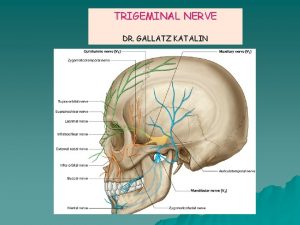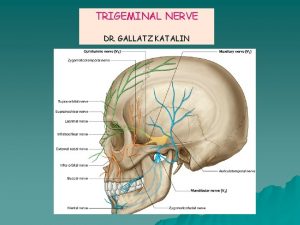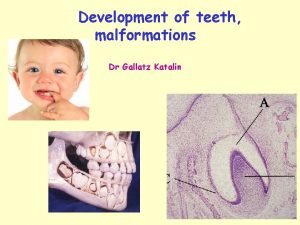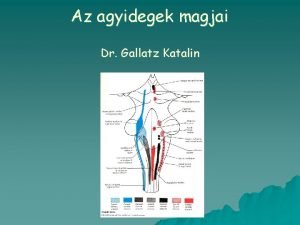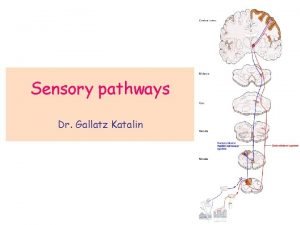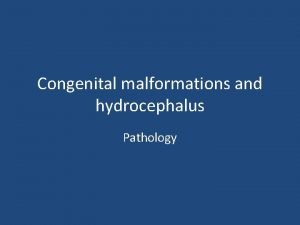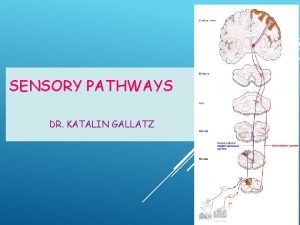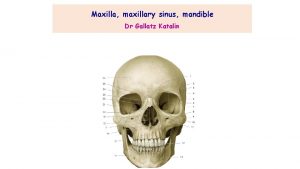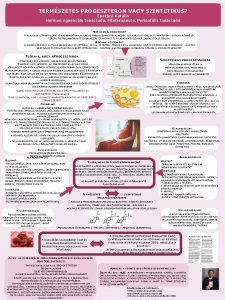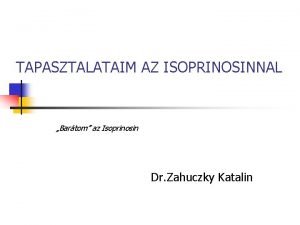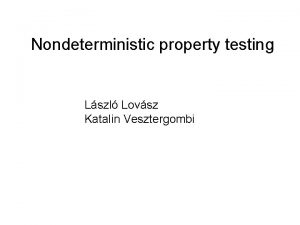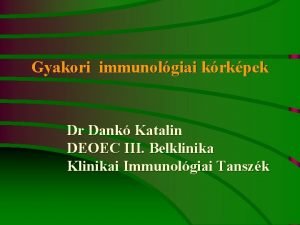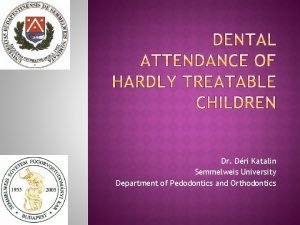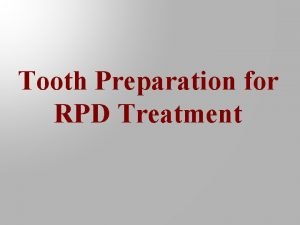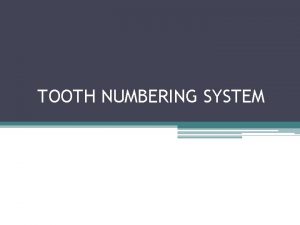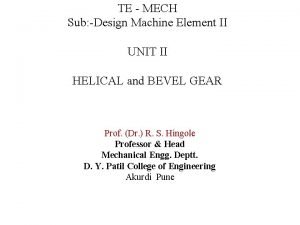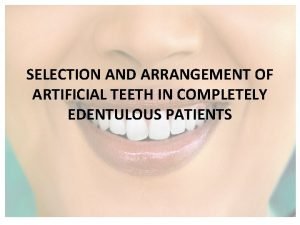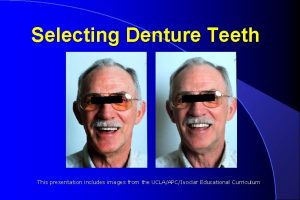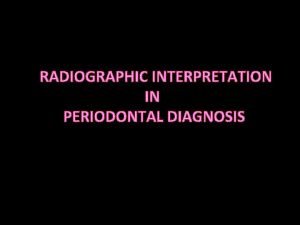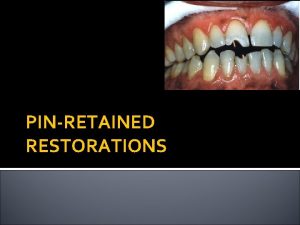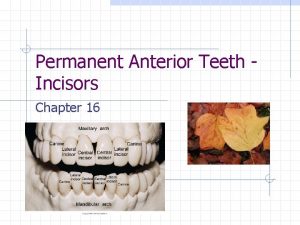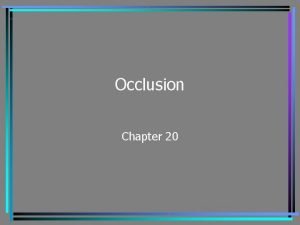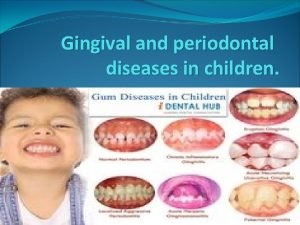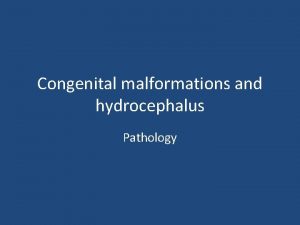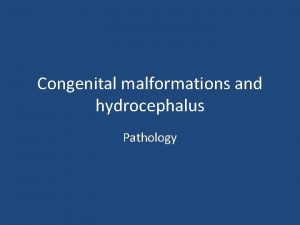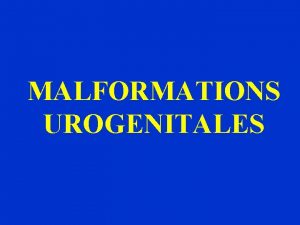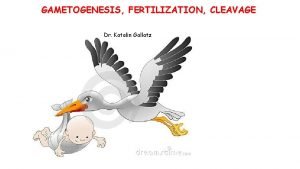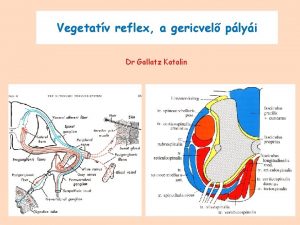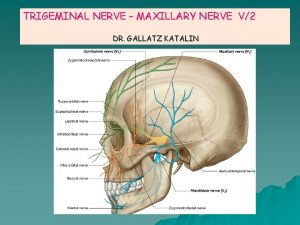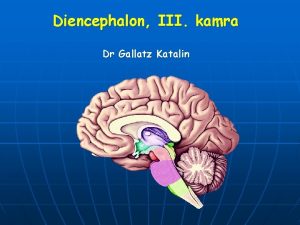Development of teeth malformations Dr Gallatz Katalin DEVELOPMENT


























































- Slides: 58

Development of teeth, malformations Dr Gallatz Katalin

DEVELOPMENT OF THE CROWN DEVELOPMENT OF THE ROOT ERUPTION MALFORMATIONS


The development of the teeth starts at 6 th week with the proliferation of the ectoderm of the stomodeum


-The tooth development starts in the 6 th week, with the formation of the dental lamina from the oral epithelium. -The dental laminaes (U-shaped bands) follow the curves of the primitive jaws. Dental lamina

Dental lamina - Each dental lamina develops ten centers of proliferation, the tooth buds of the decidous teeth. -The tooth buds of the permanent teeth appear later on the palatine or lingual aspect of the decidous teeth

1 TOOTH DEVELOPMENT • • 2 initiation stage – 6 th to 7 th week bud stage – 8 th week cap stage – 9 th to 10 th weeks EO bell stage – 11 th to 12 th weeks 3 EO – enamel organ 4 • apposition stage • maturation stage

CAP STAGE BELL STAGE ENAMEL ORGAN DENTAL SAC The mesenchyme invaginates into the tooth buds resulting the cap stage than the bell stage

CAP STAGE • Enamel organ • Dental papilla • Dental sac (follicle)

PARTS OF THE DEVELOPING TEETH ECTOMESENCHYME ECTODERM Enamel organ ENAMEL (from the neural crest) Dental papilla Dental sac DENTIN CEMENT PULP PERIODONTAL LIG. ALVEOLUS

DS DP

DENTAL SAC ENAMEL ORGAN DENTAL PAPILLA

Parts of the developing tooth enamel organ dental papilla dental sac ameloblasts – enamel producing cells differentiate from the inner enamel epithelium odontoblasts – dentin producing cells differentiate from the ectomesenchymal cells of the dental papilla (neural crest origin) enamel knot

ENAMEL KNOT – SIGNAL CENTER * Non-dividing cells from the inner enamel epithelium, • produce different signal molecules, which transport the information between the ectodermal and ectomesenchymal cells BMP, FGF, Sh. H, activin enamel knot


Tooth formation: Initial stages - development of the dental lamina - neural crest cells migrate into the developing mesenchyme - a basement membrane separates the developing oral epithelium and mesenchyme The initiation of tooth formation starts around the 37 th day of gestation.

CAP STAGE • Tooth bud proliferates and forms a cap shaped organ • this stage marks the beginning of histodifferentiation (differentiation of tissues) • the tooth germ also begins to take on form – start of morphodifferentiation • enamel organ is formed – produces the future enamel (ectodermal origin)

CAP STAGE Below this cap is a condensing mass of mesenchyme (ectomesenchyme) – dental papilla – produces the future dentin and pulp tissue. The basement membrane separating the enamel organ and the dental papilla becomes the future site for the dentinoenamel junction (DEJ) • The mesenchyme surrounding the enamel organ is the dental sac

• enamel organ + dental papilla + dental sac is considered the developing tooth germ • tooth germs are found in the developing dental arches primary dentition • Enamel organ • Dental papilla • Dental sac (follicle) CAP STAGE

Bell Stage • Continuation of histodifferentiation and morphodifferentiation • differentiation produces 4 cell layer within the ENAMEL ORGAN – 1. inner enamel epithelium – 2. outer enamel epithelium – 3. stellate reticulum – 4. stratum intermedium


LAYERS OF THE ENAMEL ORGAN

• DENTAL PAPILLA undergoes differentiation and produces two types of cells 1. outer cells of the DP –ectomesenchymal cells differentiate into dentin-secreting cells odontoblasts 2. central cells of the DP form the connective tissue of the pulp Dental sac/follicle increases its collagen content and differentiates at a later stage than the EO and DP Bell Stage



APPOSITION AND MATURATION

APPOSITION MATURATION DENTINOGENESIS: first the odontoblasts produce predentin (organic material) mineralization zománc szekréció AMELOGENESIS: the first layer of predentin induces the inner enamel epithelial cells, they differentiate into ameloblasts and secret the organic matrix of the enamel, mineralization ECTO-MESENCHYMAL INTERACTIONS dentin szekréció

APPOSITIONAL STAGE 1 1. oral ep. 2. outer enamel ep. 3. stellate reticulum 4. inner enamel ep. 5. dental papilla 6. cervical loop 2 3 4 5 blood vessels 6 http: //www. iob. uio. no/studier/undervisning/histologi/index. php

APPOSITIONAL STAGE 8 1. dental papilla 2. preameloblasts 9 3. Preodontoblasts 4. odontoblasts 6 7 5. predentin 6. ameloblasts 7. dentin 5 2 4 8. stratum intermedium 9. enamel 3 1 http: //www. iob. uio. no/studier/undervisning/histologi/index. php

DIFFERENTIATION OF THE AMELOBLASTS

DIFFERENTIATION OF THE AMELOBLASTS

Amelogenesis – Ameloblasts (enamel producing cells) 1. phase: granular process appears on the apical surface of the ameloblasts the Tomes-process, it comes off and forms the organic matrix 2. phase: calcification (mineralisation and maturation) 4 micrometer thick enamel layer/day Retzius lines.

Stages of the amelogenesis 1. stage of the secretion 2. stage of the preabsorption 3. stage of the maturation

Summary of the development of the crown 1. Formation of the dental lamina 2. Formation of the enamel organ and the preameloblasts 3. Formation of the dental papilla and odontoblasts 4. Secretion of the predentin 5. Differentiation of the ameloblasts amelogenesis 6. Mineralization of the dentin mineralization of the enamel 7. End of the amelogenesis secretion of the Nasmyth’s membrane

TOOTH DEVELOPMENT Development of the crown


DEVELOPMENT OF THE ROOT HERTWIG’S ROOT SHEATH


HERTWIG-root sheath Composed by the inner and outer enamel epithelium

DEVELOPMENT OF THE ROOT 1. Formation of the Hertwig’s root sheath 2. Formation of the odontoblasts

DEVELOPMENT OF THE ROOT 3. dentinogenesis 4. desintegration of the Hertwig’s sheath 5. formation of the epithelial islands of Malassez

DEVELOPMENT OF THE ROOT 6. cementogenesis

Development of the root


ERUPTION • Axial movement toward oral epithelium starts when the root develops. http: //www. anat. ucl. ac. uk/research/arnett_lab/ 1 mm


Changes in epithelium during eruption enamel cuticle oral ep. junctional ep. reduced enamel ep.

ERUPTION Alveolar bone and connective tissue are resorbed as teeth erupt. osteoclasts http: //www. anat. ucl. ac. uk/research/arnett_lab/


Timetable for tooth development

Development of permanent dentition Embryonic age 0 1 Primary incisor Permanent incisor 2 bud 3 4 5 Cap bell mineralization of crown bud Cap 6 bell tooth germs of primary teeth dental lamina tooth germs of permanent teeth 7 8 months mineralization

Abnormalitis of the teeth 1. Abnormal number of the teeth total anodontia (anodontia totalis) supernumerary teeth (dentes supernumerarii) 2. Abnormal shape of the teeth fused teeth twinning of teeth 3. Abnormal size of the teeth microdontia (small teeth) macrodontia (large teeth)

Molecular mechanism of tooth development • Many genes control tooth development - shape, number of cusp (incisor, molar) – size – number (2 vs 3 molars…. . ) – location (mesio-distal, maxillo-mandibular…. ) – timing of formation and eruption

Abnormalitis of the development of the enamel 4. Amelogenesis imperfecta mutation of the amelogenin or enamelin genes amelogenesis imperfecta

Abnormalitis of the development of the dentin 5. Dentinogenesis imperfecta DSPP GENE MUTATION (dentinsialo-phosphoprotein) Dentinogenesis imperfecta

Summary of the tooth development

Thank you for your attention! Tooth development - You. Tube
 N auriculotemporalis
N auriculotemporalis Dr gallatz katalin
Dr gallatz katalin Stria olfactoria medialis
Stria olfactoria medialis Csíralemezek származékai
Csíralemezek származékai Tooth development histology
Tooth development histology Truncus coeliacus
Truncus coeliacus Dr gallatz katalin
Dr gallatz katalin Epicritic touch
Epicritic touch Dr gallatz katalin
Dr gallatz katalin Ventral pallidum
Ventral pallidum N lingualis
N lingualis Congenital malformations
Congenital malformations Fascicle of goll and cuneate fascicle
Fascicle of goll and cuneate fascicle Maxillary sinus
Maxillary sinus Eperjesi katalin hormon
Eperjesi katalin hormon Dr zahuczky katalin rendelés
Dr zahuczky katalin rendelés Katalin ruszik
Katalin ruszik Katalin vesztergombi
Katalin vesztergombi Unicitás
Unicitás Dr zahuczky katalin rendelés
Dr zahuczky katalin rendelés Keltai katalin
Keltai katalin Pintr
Pintr Szoboszlai katalin
Szoboszlai katalin Varga katalin eszter
Varga katalin eszter Radnóti katalin
Radnóti katalin Kopf katalin
Kopf katalin Fried katalin
Fried katalin ámon katalin
ámon katalin Gundel katalin
Gundel katalin Gottron jel
Gottron jel Liktor katalin
Liktor katalin Katalin parti
Katalin parti Eperjesi katalin
Eperjesi katalin Dr botos katalin
Dr botos katalin Dr déri katalin
Dr déri katalin Humánspecifikus motívumok
Humánspecifikus motívumok Podjebrad katalin
Podjebrad katalin Pile worms teeth
Pile worms teeth Incisal labiality
Incisal labiality Guide planes in rpd
Guide planes in rpd Tooth numbering system types
Tooth numbering system types Examples of omnivores
Examples of omnivores Tredgold approximation
Tredgold approximation Monoplane teeth
Monoplane teeth Monoplane occlusion
Monoplane occlusion Curve of spee and wilson
Curve of spee and wilson Squint test is used as a guide for selecting
Squint test is used as a guide for selecting Vertical
Vertical Foot feet tooth teeth
Foot feet tooth teeth Woman feet
Woman feet Placing pins in teeth
Placing pins in teeth Central incisor line angles
Central incisor line angles Curve of wilson
Curve of wilson Lingualized occlusion vs balanced occlusion
Lingualized occlusion vs balanced occlusion Convex vs concave teeth
Convex vs concave teeth Song lyrics with literary devices
Song lyrics with literary devices Horizontal distortion
Horizontal distortion Drywall rip saw
Drywall rip saw Retrocuspid papilla interdental clefts in primary teeth
Retrocuspid papilla interdental clefts in primary teeth
